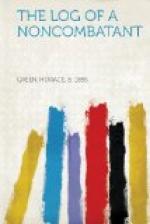Antwerp, the temporary capital of Belgium, was at this time invested, but not yet besieged, by the German army. On the south the city was already cut off by several regiments of the Ninth and Tenth German Army Corps under General von Boehn. The River Scheldt and the Dutch border formed a wall on the north and west. It was to Antwerp, therefore, that we determined to go. After listening to the usual flood of warnings against entering the fighting zone, and drinking our fill of stories of atrocity and hate which every refugee brought across the border into Holland, we took a couple of reefs in our baggage, and, hoisting our knapsacks, set our course for the temporary Belgian capital. By rail we traveled south across the level fields and lush green meadows of Holland, over bridges ready to be dynamited in case of invasion, and through training camps of the 450,000 Dutch soldiers then mobilized along the border. At a little town called Eschen the train stopped because the Belgians had torn up the tracks.
Seated on the cross-piece of a joggling two-wheeled ox cart, moving at the rate of not more than four miles an hour, with a dumb specimen for a driver, and a volume of Baedeker for interpreter and guide, we got our first glimpse of the hideous thing called war. Judging from the looks of the country and the burning villages, we were on the heels of a devastating army. For three, four, and five miles on either side of the road beautiful trees lay flat upon the ground. It was not until we saw groups of Belgian soldiers tearing down their own walls and hedges and applying match and gasolene to those which still stood, that we realized that this was a case of self-inflicted destruction. Farmhouses, stores, churches, old Belgian mansions, and windmills were either in flames or smouldering ruins. Where burning had not been sufficient, powder and dynamite had been applied to destroy landmarks which for centuries had been the country’s pride. As far as the eye could reach the countryside was flattened to a desert. It reminded me of the Salem fire, through which, while the piles of debris were still smoking, I had been taken in the “Boston Journal’s” car. But instead of a single town, here for twenty miles along lay stretched a smouldering waste. The devastation was for the defensive purpose of giving an unobstructed view to the cannon of Antwerp’s outer fortifications, which on that side covered one sector of the circle swept by her enormous guns.




